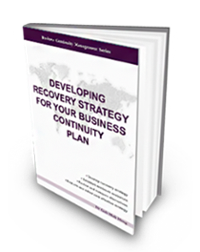1 Business Continuity (BC) Planning
In some circumstances, where organisations do not have existing BC plans already in place, business recovery plans need to be developed. This plan entails the resumption of business operations if staff members had been quarantined for five days, and the health authorities had shut the premises for 1 to 5 days.
It is imperative for such organisations to consider the development of recovery and resumption plans for critical business functions. Otherwise, the organisation must be prepared to suffer financial and non-financial losses, which are sometimes irrecoverable.
2 Infectious Disease BC Planning
![]() It is recommended that organisations with more than 50 staff members should proceed to develop a “complete” BC plan because of the impact and the cost of not doing it. The need for a budget to manage this healthcare-related incident requires a formal approach to developing the recovery and resumption process.
It is recommended that organisations with more than 50 staff members should proceed to develop a “complete” BC plan because of the impact and the cost of not doing it. The need for a budget to manage this healthcare-related incident requires a formal approach to developing the recovery and resumption process.
 The detailed steps of the entire BCM planning methodology found in chapter 1 have been further broken down into respective phases and are available in the BCM Series.
The detailed steps of the entire BCM planning methodology found in chapter 1 have been further broken down into respective phases and are available in the BCM Series.
For organisations with less than 50 staff members and where resources do not support a separation of the premises, here is a “fast track” approach to developing an “interim” Infectious Disease plan.
3 Project Management
 This is the start of the infectious disease BC planning process and typical, a corporate Infectious Disease project team is set up to:
This is the start of the infectious disease BC planning process and typical, a corporate Infectious Disease project team is set up to:
- Establish a project plan.
- Agree on the timeline.
- Develop an overall strategy.
As this is a simplified version of the project management phase, readers who are keen to learn more about the detailed steps for this particular BC phase can look for further reading from the author’s book entitled “Managing Your Business Continuity Planning Project” in the BCM Series.

4 Risk Analysis and Review
In this phase, the threat is “Infectious Disease” and it is very specific. It includes diseases such as Zika, Ebola and Measles and pandemic influenzas such as MERS-CoV, H5N1, and H7N9 and, of course, COVID-19. The conduct of this phase is kept to a minimum.
5 Business Impact Analysis
 Identify critical business functions or essential services based on the Infectious Disease disaster scenario.
Identify critical business functions or essential services based on the Infectious Disease disaster scenario.
- What is the organisation’s stand when the outbreak of the Infectious Disease occurs?
- Maintain business as usual.
- Operate in disaster mode.
If a Business Impact Analysis (BIA) report is already in existence, proceed to review the impact of each critical business function regarding the Infectious Disease threat.
Critical Business Functions or Essential Services
Critical business functions or essential services are those that are deemed to be essential or crucial to an organisation’s operations. These can be serviced to either external or internal customers.
One important criterion to apply in assessing the criticality of service is whether the impact resulting from a 5-day service suspension (along the line of quarantine duration) is tolerable. If services are suspended for a prolonged duration (exceeding five days), will this adversely impact:
- The essential business functions relating to customers?
- Ability to meet the goals and commitment to some critical initiatives or events?
- Are the support services essential for staff to carry out their work?
Simplified BIA for Infectious Disease BC Planning
The following steps will assist in developing a simplified BIA for Infectious Disease:
- List all business functions.
- Assign Infectious Disease Impact Ratings for each function (for example, 1 = Low, 2 = Medium and 3 = High).
- Assign Recovery Priority Ratings for each function.
- Determine maximum timescale for carrying out each business function during a crisis.
- Determine upstream and downstream dependencies.
As this is a simplified version of the business impact analysis phase, readers who are keen to learn more about the detailed steps for this particular BC phase can look for further reading from the author’s BCM Book Series entitled “Conducting Your Business Impact Analysis.”
6 Business Continuity Strategies
Short Term BC Strategy (1 to 15 days)
 Some commonly deployed recovery strategies to counter a potential Infectious Disease outbreak/quarantine include:
Some commonly deployed recovery strategies to counter a potential Infectious Disease outbreak/quarantine include:
- Provide facilities for telecommuting.
- Work with reduced personnel.
- Cross-train staff members to temporarily replace those who may be quarantined.
- Relocate staff members to alternate office locations.
- Split staff into two or more shifts.
- Replace routine communication with alternate forms of interaction such as teleconferencing, videoconferencing, fax, and emails.
Long Term BC Strategy (15 days to 3 months)
Some commonly used long term BC strategies include:
- Provide additional manpower by another agency that is competent in the operations.
- Relocate some staff members to areas not stricken by the outbreak.
- This strategy may not work as Infectious Disease could spread to the relocated area.
- Continue to maintain only essential business functions.
- Split functional business units for organisations with 2 or more existing offices but re-engineer processes to ensure that efficiency is not compromised should this strategy be adopted for the long term.
- Relocating staff to alternate facilities and splitting of personnel based on shifts are initial responses but cannot be long-term solutions.
An example is a strategy for the egg industry in the United States. These are the four main strategies that were adopted:
- Implement a quarantine zone when there is an outbreak.
- Implement a “Universal Stop” movement order for egg distribution.
- Manage the impact on the trust in the food system by the public.
- Manage unintended economic consequence and impact on the industry
7 Strategy Considerations
In this BCM planning phase, most BC planners would have the tendency to focus on detailed recovery processes and procedures. This focus caused many organisations to waste their efforts as the “high level” recovery strategy is not made explicit and approved in principle by executive management. Some of these factors that need management’s approval include:
- Location of employees.
- Distribution of work.
- The scope of recovery.
- Based on critical business functions derived from the BIA.
- Knowledge management.
- Determine how knowledge/data is protected and made available to staff members during the recovery mode.
- Communication processes.
- Company policies.
Alternate Office Locations
Where alternate locations are available, do the following:
- Split each critical business unit into 2 or more work teams.
- Physically separate the two teams to be located in different zones or buildings.
- Build technology infrastructure to support connectivity.
- Splitting of Staff into Two or More Different Shifts
Some organisations may decide to operate from various sites. In general, the main options available are:
- Relocate some of the staff members (but beware as the other locations could be affected by the Infectious Disease):
- Overseas
- To non-infected stricken areas.
- Request critical functions to be supported by:
- Headquarters
- Regional Offices.
- Pre-arrange “reinforcement” from:
- Competitors
- Professional Associations.
- Government
- Prepare and update alternate site for disaster recovery.
- Prepare an emergency (alternate) site if the work area is contaminated.
 Create a team working from another location as a ready backup if the office becomes infected.
Create a team working from another location as a ready backup if the office becomes infected.
The content above is a simplified version of the BC strategy phase. Readers interested in learning more in-depth about the detailed steps for this BC phase can refer to the author’s book entitled “Developing Recovery Strategy for Your Business Continuity Plan” in the BCM Series.
Do You Want to Continue Training During A COVID-19 Pandemic Outbreak?
| Back To | ||||
|
|
Reference GuideGoh, M. H. (2016). A Manager’s Guide to Implement Your Infectious Disease Business Continuity Plan, 2nd Edition. GMH Pte Ltd. |
 |
 |
|




![[BL-3-Catalog] What Specialist Level Blended Learning Courses that are Available?](https://no-cache.hubspot.com/cta/default/3893111/4b22a53c-6e3e-4b9e-8c2a-888423f1d26c.png)
![[BL-5-Catalog] What Expert Level Blended Learning Courses that are Available?](https://no-cache.hubspot.com/cta/default/3893111/fe175db3-7f57-4636-bf09-e9a836aa5478.png)


